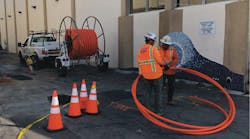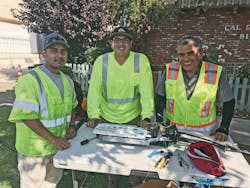Latest from FTTx/Optical Networks
Fiber Techs on the Job Training (OJT) is a Necessity
Training fiber optic techs is easier if you understand how they learn. They learn by doing their work.
Is that the ideal? Maybe. Maybe not. But it is the reality that our industry has created. And as work force shortages continue in fiber optic construction (or tele-construction), the need for strong on-the-job training (OJT) continues to increase.
I started training techs in fiber optics 40 years ago as a matter of necessity. We were selling our fiber optic test equipment to newcomers who had no idea what they were doing. I had one customer in particular, Digital Equipment Corporation (DEC), the minicomputer company, that was introducing their first fiber optic products and needed to train 800 field service techs to install and service them.
Today, all techs have a smartphone, laptop and/or tablet they can use to get information from the web while being on their jobsite. With a basic understanding of one process, new techs can find instructions and videos to extend their learning and do almost any installation.
As a result, we created a lecture introducing them to fiber optics and a lab to show them how to use our test equipment. Soon after, they asked for training to install and terminate cables, so we created a one-day program for that and instead of training all 800 techs, we trained the trainers. They loved learning a new technology and picked up the new skills in no time.
The next step was to determine if the techs could pick up fiber optic skills as quickly as the trainers. We weren’t disappointed. The techs were used to having new products and technology thrown at them and enjoyed working with their new “toys”. Like the trainers, they had their own fiber optic installation equipment so they could practice until they felt comfortable enough to work on their customers' equipment.
We continued training techs like this for years. We expanded to two or three days and added more complex processes like fusion splicing and OTDR testing. Still, the training structure process remained the same. It included a "boot camp" session with 50% of the time being hands-on labs. The more time techs spent learning and practicing the skills, the more competent they felt to continue their learning on the job.
Evolving OJT
Today, all techs have a smartphone, laptop and/or tablet they can use to get information from the web while being on the jobsite. With a basic understanding of one process, new techs can find instructions and videos to extend their learning and do almost any installation. If they still have questions, they often contact the manufacturers or us at the FOA for advice.
We tend to think of OJT as an individual thing with each tech following his or her own course. But there is a better way, structured OJT. Structured OJT adds lesson plans for the tech to follow and provides learning goals that the tech and supervisors or mentors can use to gauge the tech's achievements.
For example, techs start with an online fiber optic course and get a certificate of completion showing they have achieved a level of knowledge. Next, they take an online course covering the skills they are expected to have on their job, like splicing fiber or testing. As they practice the skills in the field, their supervisor or mentor oversees their work and provides guidance. When that skill is learned, they move along to another. In a structured program, they can even achieve FOA certification.
The techs were used to having new products and technology thrown at them and enjoyed working with their new "toys”. Like the trainers, they had their own fiber optic installation equipment so they could practice until they felt comfortable enough to work on their customers' equipment.
Contractors today rely on OJT for the majority of their techs' training. Some complain that classroom training is expensive, but most know the payback is big. Once a tech has been through the basic training, companies can rely on OJT to keep their techs up to date on new products and technologies while not losing the precious time they are needed on the job. As the market grows, companies need more techs, so training new hires is a continual process they must always improve.
In September, we’ll share ways to get your techs the best OJT. The right OJT strategies will reward you with productive fiber optic techs who are more likely to continue learning and less likely to jump ship when you need them.
*Caption for opening image: OJT in fiber optics often begins by learning construction techniques.
ABOUT OUR FIBER OPTIC EXPERT
Jim Hayes is the Fiber Optic Expert columnist for ISE Magazine. He is a lifelong techie who has been involved in the fiber optic industry since the late 1970s. He founded one of the world's first fiber optic test equipment companies, FOTEC, which was acquired by Fluke in 2000, and he was a co-founder of the Fiber Optic Association (FOA), the international professional society of fiber optics, in 1995.
Jim is a writer and trainer and the President of FOA. He is the author of nine books on fiber optics and cabling and writes for several magazines.
Jim and his wife, Karen, who is the GM of the FOA, have traveled the world for the FOA helping set up schools to train the workers who design, build, and operate today's communications networks. The FOA offers nearly 1,000 pages of online technical materials, over 100 videos, and two dozen free self-study courses online.
For more information, email [email protected] or visit www.jimhayes.com. To learn more about the Fiber Optic Association, visit www.thefoa.org.
What exactly is OJT? On-the-job training is learning while doing, beginning with some basic training, adapting it to the job at hand, and learning by repetition. The basic training may come from a training class, in person or online, being mentored by a supervisor or co-worker, or having a quick demo/hands-on training from the supplier of a component or equipment. Once the tech has the basic skills, he or she becomes better with experience. Ever hear the sports analogy that it takes 10,000 repetitions to become competent? And since every job is different, they use their basic knowledge to figure out what works best in each situation. Every job becomes a learning experience.

Jim Hayes | Fiber Optic Expert
Jim Hayes is the Fiber Optic Expert columnist for ISE Magazine. He is a lifelong techie who has been involved in the fiber optic industry since the late 1970s. He founded one of the world's first fiber optic test equipment companies, FOTEC, which was acquired by Fluke in 2000, and he was a co-founder of the Fiber Optic Association (FOA), the international professional society of fiber optics, in 1995.
Jim is a writer and trainer and the President of FOA. He is the author of nine books on fiber optics and cabling and writes for several magazines.
Jim and his wife, Karen, who is the GM of the FOA, have traveled the world for the FOA helping set up schools to train the workers who design, build, and operate today's communications networks. The FOA offers nearly 1,000 pages of online technical materials, over 100 videos, and two dozen free self-study courses online.
For more information, email [email protected] or visit www.jimhayes.com.
To learn more about The Fiber Optic Association, visit www.thefoa.org. Follow them on Facebook: FiberOpticAssociation, LinkedIn: company/the-fiber-optic-association-inc-foa, and YouTube: user/thefoainc.





